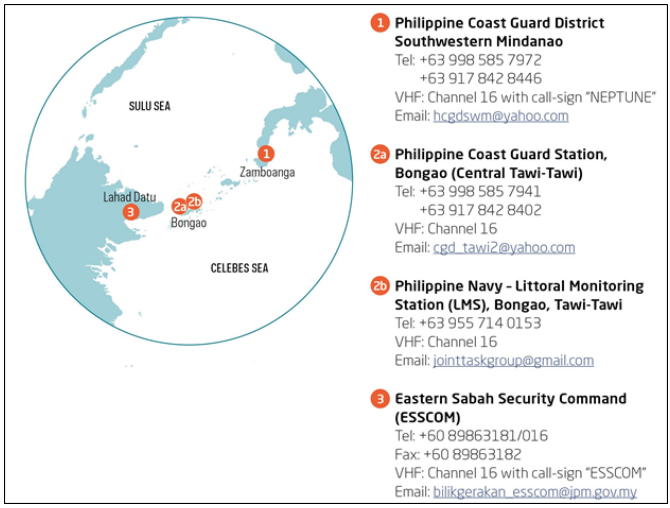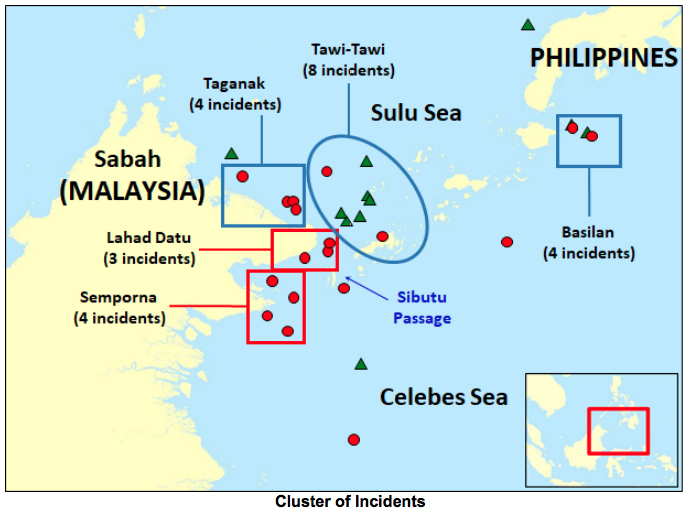The ReCAAP ISC has released its latest publication in 2019: “Guidance on Abduction of Crew in the Sulu-Celebes Seas and Waters off Eastern Sabah.”
This Guidance focuses on the incidents of abduction of crew from ships for ransom in the Sulu-Celebes Seas and in the waters off Eastern Sabah. It provides the guidance and analysis based on the information collected from past incidents in order to assist the shipping industry and ships to enhance their situation awareness and avoid such incidents. This guidance complements the general guidance contained in the “Regional Guide to Counter Piracy and Armed Robbery against Ships in Asia” [available at www.recaap.org]. The Sulu-Celebes Seas region covers the tri-boundary area of the Philippines, Malaysia and Indonesia. It is strategically located and most international shipping passes through its maritime sea lanes. In the Sibutu Passage alone, an average of 14,000 ships passes yearly. Prior to 2016, there were kidnaps for ransom on land in the region carried out by the Abu Sayyaf Group (ASG), an Islamic extremist group based in Southern Philippines. On 26-March-2016, the first abduction of crew from ship was reported. It involved the tug boat, Brahma 12 and 10 of the Indonesian crew on board the boat were abducted. Since then, spates of abduction of crew incidents were reported in 2016, 2017, 2018 and 2019.
During the period of 2016 to June 2019, Philippine Coast Guard (PCG) reported to ReCAAP ISC a total of 29 incidents of abduction of crew (comprising 18 actual incidents and 11 attempted incidents). In 2016, a total of 18 incidents of abduction of crew (comprising 12 actual incidents and 6 attempted incidents) were reported. In 2017, the number of incidents reduced to 7 (3 actual incidents and 4 attempted incidents). In 2018, the number of incidents further reduced to 3 (2 actual incidents, and 1 attempted incident). There was one actual incident reported in June 2019. In the 18 actual incidents, 75 crew were abducted. Among them, 65 were released/rescued, and 10 crew were killed/died. No crew was held in captivity.
Despite the decrease in number of incidents, and military and law enforcement efforts by the Philippine authorities, the perpetrators of the ASG remain active in the region, looking for any opportunity to abduct crew from ships.
Targets. Tug boats and fishing boats were the main victims of abduction of crew, due to their slow speed and low freeboard. Of the 18 actual incidents, the perpetrators who abducted the crew boarded 15 tug boats and fishing boats. Among them, 9 incidents involved fishing trawlers/fishing boats and 6 incidents involved tug boats of 60-363 GT. The other 3 ships of actual incidents were 2 bulk carriers (less than 300 GT) and 1 general cargo ship (11,391GT). There were 11 attempted incidents, involving bigger ships. These included 6 bulk carriers of 18,000-93,200 DT, 2 container ships, 1 product tanker (5,600 GT), 1 general cargo ship (1,600 GT) and 1 ferry boat.
Clusters. Of the 29 incidents, there were incidents that occurred in close proximity to each other. The incidents are grouped in the following clusters: off Tawi-Tawi, Philippines (8 incidents; 2 actual, 6 attempted); off Taganak, Philippines (4 incidents; 3 actual, 1 attempted); off Basilan, Philippines (4 incidents; 2 actuals, 2 attempted); off Semporna, East Malaysia (4 incidents; all actual); off Lahad Datu, East Malaysia (3 incidents; all actual).
Although the number of incidents in the cluster off Tawi-Tawi is the highest with 8 incidents, 6 of these incidents were attempted incidents where the perpetrators were not successful in boarding the ships. Most of the attempted incidents occurred further away from the coast, and involved bigger ships that adopted evasive maneuvers and successfully escaped from the pursuing perpetrators’ boats.
Location. Of the 18 actual incidents, incidents involving tug boats (9) and fishing boats (6), mostly occurred in the northwest and southwest of the Sibutu Passage. Majority of these incidents occurred close to shore. The other 3 actual incidents involved 2 bulk carriers and 1 general cargo ship, which took place further away from the shore. The map below shows the locations of abduction of crew of the 18 actual incidents.
Time. Of the 29 incidents, 20 occurred during daylight hours (69%) and 9 incidents occurred during darkness (31%). Among the 20 incidents reported during daylight hours, the frequently targeted hours were 1000-1059 hrs (3 incidents), 1200-1259 hrs (3 incidents) and 1700-1759 hrs (3 incidents). Contrary to the other incidents of piracy and armed robbery against ships in Asia, which take place mostly during darkness, most of the incidents of abduction of crew in the Sulu-Celebes Seas and waters off Eastern Sabah occurred during daylight hours.
Rationale. In the 18 actual incidents, the perpetrators abducted crew for ransom money. Three incidents reported that, in addition to abducting crew, perpetrators stole crew’s cash and personal belongings, ship GPS, VHF radio, navigational equipment and ship compass. It is clear that the main motive of the perpetrators is to abduct crew to demand ransom money.
Weapons. Of the 29 incidents, 8 incidents involved groups of 5 men. The number of perpetrators in the other 20 incidents varied between 2 and 20 men. Most of the incidents involved perpetrators armed with firearms (26 incidents). The firearms were not discharged in most of the incidents except for 3 incidents where shots were fired to force the victim ships to stop, or to open the cabin doors, or during a shoot-out between the perpetrators and the Philippine authorities.
Ship of Perpetrators. In most incidents, the perpetrators used speed boats to chase after the victim ships. In the 18 actual incidents, 13 incidents reported that the perpetrators used speed boats, 3 incidents used jungkong pump boats, 1 used a motor banca, and 1 with no information available. The speed boats used were of different colors e.g., grey, white, blue, green with white stripes, green and grey, white and blue, and orange and white.
The ASG, an Islamic extremist group based in southern Philippines, claimed most of the incidents of the abduction of crew from ships. The ASG is responsible for the spate of said incidents wherein most of the kidnap victims were held in captivity in the hinterlands of Sulu for ransom. The ASG is known to utilize jungkong type of boats to prey on low freeboard and slow-moving ships. Specifically, the group operates within Sulu and Tawi-Tawi, which are considered to be their lair. Allegedly, the ASG has strong networking with other lawless elements based in Malaysia and Indonesia. Recently, members of the ASG group pledged allegiance to Abu Bakar Baghdadi (ISIS).
On 16-February-2018, container ship, Kudos 1 was underway at approximately 4.4 nm southeast of Sibago Island, Basilan, Philippines, when 3 motorized bancas with 3 perpetrators on board, each banca maneuvered to the portside amidship of Kudos 1. Armed with firearms, the perpetrators attempted to board the ship using ropes and hooks. The master and crew splashed hot water onto the perpetrators who opened fire at the ship for about 2 minutes and re-positioned themselves at about 400-500 meters away from the ship. The master also activated 2 flares. The perpetrators escaped quickly in the motorized bancas and sped heading towards Basilan. Three crew suffered minor injuries on their hands due to the glass debris from the ship’s porthole mirror, which shattered due to gun shots.
The Philippine authorities were alerted to the distress signal and immediately responded by deploying assets to the location of the incident. The PCG boarded the ship and provided medical treatment to the injured crew. The PCG and Philippine Navy escorted the ship safely towards the port of Zamboanga City.
Transit Corridors and Notice to Mariners (NOTAM) by the Philippines and Malaysia. On 14-July-2016, Indonesia, Malaysia and the Philippines signed the Trilateral Cooperative Arrangement (TCA) to address security challenges in the maritime areas of common concern. The 3 countries agreed to encourage operationalization of the Standard Operating Procedure (SOP) for maritime patrol: operating guidelines on information and intelligence sharing; and the combined communication plan. The 3 countries established the Maritime Command Centres (MCCs) in Tarankan (Indonesia), Tawau (Malaysia) and Bongao (Philippines) for this purpose. The MCCs serve as the operational command and monitoring stations for these countries. Under the TCA, the Philippines and Malaysia established the transit corridors within the Area of Maritime Interest (AMI), covering the common maritime areas. The transit corridors serve as safety areas of passage for commercial ships, and are patrolled by the 3 countries. The transit corridor established by Philippines is in “NOTAM 148-2017” issued by the PCG on 12-September-2017. The transit corridor established by Malaysia is in “NOTAM 14-August-2017” issued by Malaysia’s Marine Department.
Advisory by ReCAAP ISC. Considering the continued existence of abduction of crew threats and violent nature of the perpetrators causing fatality of 10 seafarers, the ReCAAP ISC maintains its advisory issued via the ReCAAP ISC Incident Alert dated 21-Nov-2016 as follows: Reroute from the area, where possible; Otherwise, ship masters and crew are strongly urged to exercise extra vigilance; and Report the incident immediately to the Operation Centres of the Philippines and Eastern Sabah Security Command (ESSCOM) of Malaysia.
In the event that the ship master is not able to establish contact with the Operation Centres of the Philippines as listed in the ReCAAP ISC Advisory, contact the Philippine Coast Guard Command Centre at: +63-2-5273877 (direct), +63-2-527-8481 to 89 (ext: 6136/37), +63-917-724-3682 (mobile), +63-929-825-3207 (mobile); email: pcgcomcen@coastguard.gov.ph
The contact details of the Operation Centres of the Philippines and ESSCOM of Malaysia are as follows.

Ship masters and crew are further advised to:
- Enhance vigilance, maximize alertness of lookouts, and increase watch keeping;
- Maintain continuous communication with shipping company and enforcement agencies for monitoring and immediate responses in any eventualities;
- Look out for advisories on NAVTEX;
- Refer to the latest information available at ReCAAP ISC website (www.recaap.org) and other organizations;
- Sound alarm when sighted suspicious boats in the vicinity or suspicious persons on board ship;
- Avoid confrontation with perpetrators;
- Report all incidents to the nearest coastal States and flag States in accordance with the IMO Circular MSC.1/Circ 1334.
The shipping companies and ship masters are also advised to adopt precautionary measures from the general guidance contained in “Regional Guide to Counter Piracy and Armed Robbery against Ships in Asia” such as risk assessment, company planning, master’s planning, ship protection measures, measures when ships are under attack, etc.
The ReCAAP ISC in collaboration with the PCG supported by Asian Shipowners’ Association and Singapore Shipping Association produced the “Guidance on Abduction of Crew in the Sulu-Celebes Seas and Waters off Eastern Sabah” in July 2019.
View the full report at: http://www.recaap.org/resources/ck/files/guide/Guidance%20on%20Abduction%20of%20Crew%20in%20Sulu-Celebes%20Seas%20(26%20Jul%2019).pdf
